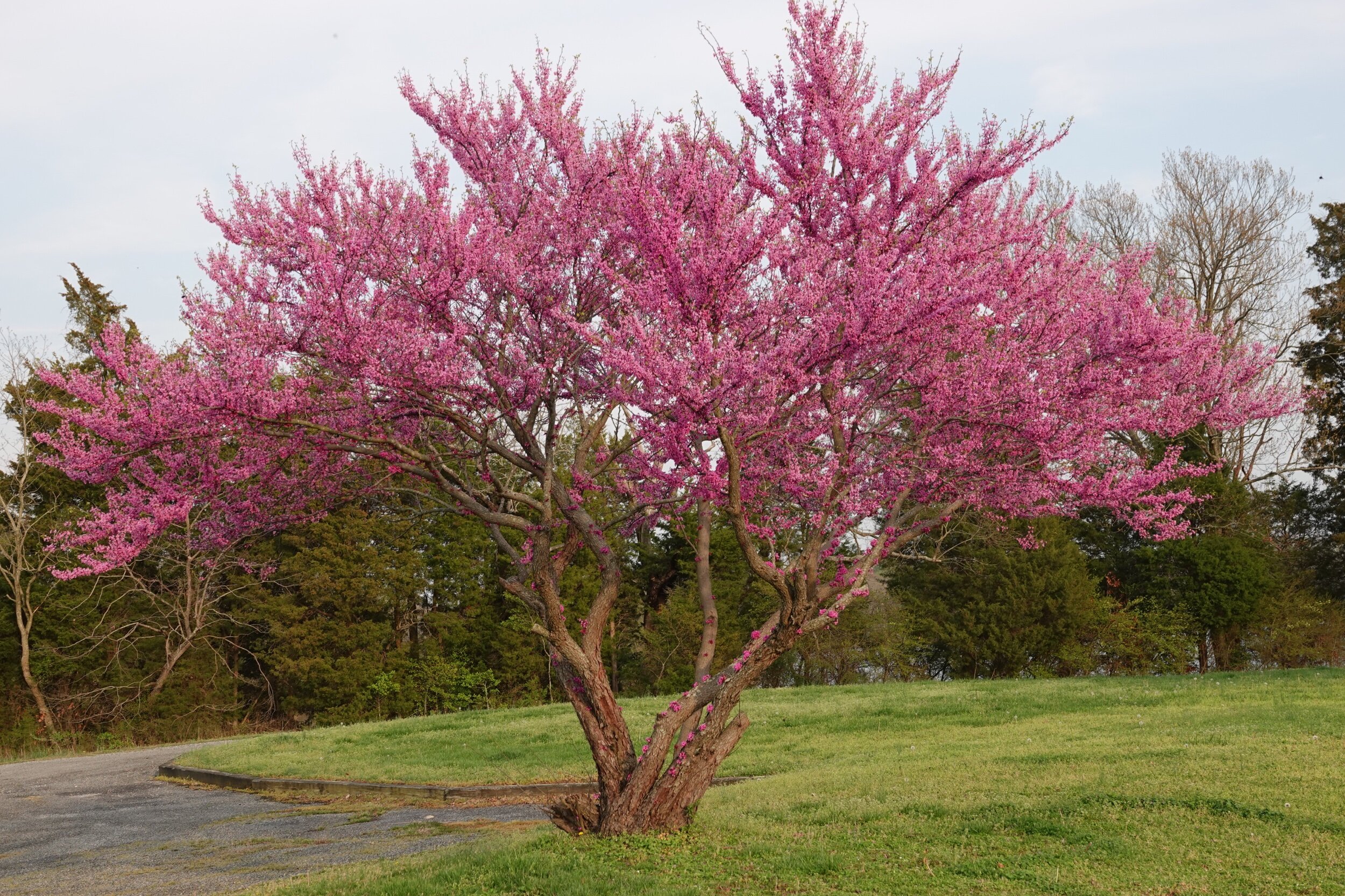Plant of the Month March 2021: Eastern Redbud
Eastern Redbud, Cercis canadensis
By Betsy Washington
As signs of spring fill the air, I find myself eagerly anticipating the vibrant magenta pink blooms of one of our most beautiful flowering trees, the Eastern Redbud, Cercis canadensis. This small tree is a common sight along roadsides, woodland edges, and old fields in Virginia in late March and early April when its showy flowers create a lovely haze of magenta in the spring landscape.
Eastern Redbud in glorious bloom at Belle Isle State Park
Eastern Redbuds are one of the most beloved deciduous understory trees. They are a member of the Pea Family with distinctive rosy-purple pea-like flowers that bloom profusely from the bare branches before the tree leaves emerge. The individual flowers are held together in tight clusters creating an incredibly dramatic spring show. The buds have the amazing ability to emerge directly from the bark of the trunk and bare branches in a process called “cauliflory” or “stem flower”. Each one-half inch flower consists of an upper petal, two flared wing petals and a pair of lower petals fused into a keel or lip and are sometimes described as looking like little rosy hummingbirds.
Eastern Redbud bark and flowers emerging from the trunk
Redbuds grow quickly, reaching 15 – 30’ in height with a spread of 20 – 35’. Often branched low to the ground, multiple graceful trunks grow in a graceful vase shape with tiered branches adding architecture and interest year-round. The bark is thin and brown developing dark brown scaly ridges and narrow furrows. Twigs are reddish brown with a distinctive zigzag pattern between the alternate leaves.
As the flowers fade, the distinctive heart-shaped leaves emerge; at first small, shiny, and tinged a beautiful bronzy- red, and hang along the branches like little valentines. Within a few weeks, the leaves fade to a lovely soft matte green and mature to 4” to 6” in width, adding an unmistakable bold texture to the landscape. In fall, leaves turn vibrant shades of yellow green to bright yellow for a second show before falling and revealing the flattened 4” long seedpods, typical of legumes. These pods turn from green to brown as fall progresses and sometimes can be surprisingly dense, persisting into winter and adding interest to the landscape not to mention food for wildlife.
Redbuds are well known for their large geographic range extending from New York and Connecticut, west to Iowa and south to Florida and west along the Gulf coast to Texas and south into Mexico. Individual redbuds may vary in hardiness and other attributes, depending on the region they evolved in, so it is always best to obtain a tree from a regional source.
Eastern Redbud flowers with Common Eastern Bumble Bee
Found in a variety of habitats from rich, moist forests, to dry barrens, and from woodlands along waterways to old fields and roadsides, redbuds are adaptable trees. They occur most commonly on calcareous soils but also do well on acidic soils. Redbuds are easy to grow, especially when transplanted at small sizes, and are relatively fast growing. They tolerate part shade to sun but the more sun, the more prolific the showy blooms will be. Redbuds prefer moist but well drained soils and do not tolerate poorly drained soils. They may live to be 50 or 75 years old but can be susceptible to cankers when stressed. They are often seen in Virginia along our roadsides bringing an eye-catching rose color to our travels in early spring.
Redbuds are an important source of nectar and pollen for early pollinators. While in bloom, they often “hum” with dozens of native bumble bees, carpenter bees, and other pollen specialists. Bumble bee Queens rely on early-blooming Redbuds as a favored nectar and pollen source, as they create a new colony each spring. They collect the pollen to make “pollen bread” on which they lay their eggs so that the larvae have a protein-rich food source when they emerge. Hummingbirds are also attracted to the nectar. Redbuds host 12 species of butterfly and moth caterpillars which in turn are critical components of baby songbird diets. The seeds are eaten by many adult birds. Humans too can get in on the feast. The flowers are edible and a great source of vitamin C and can make tasty and beautiful additions to salads, as do the young seedpods.
Eastern Redbud with stunning fall color
Redbuds make a splendid specimen tree in any garden but are also lovely planted in loose drifts along woodland edges. Consider combining them with flowering dogwoods or near the chartreuse flowers of early blooming Spicebush. As a finishing touch, underplant them with spring native wildflowers like Golden Ragwort, Spring Beauty, or Wild Blue Phlox and small flowering bulbs to enhance this spring spectacle. You will rejoice in the beauty this tree offers throughout the year.
All photos by Betsy Washington




